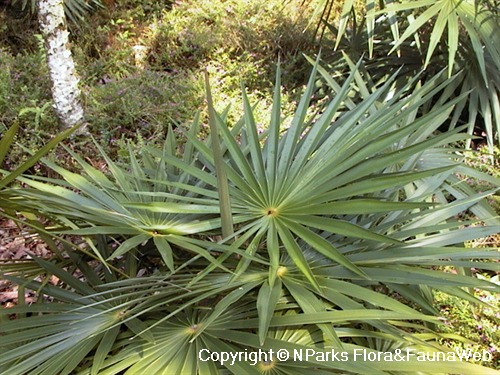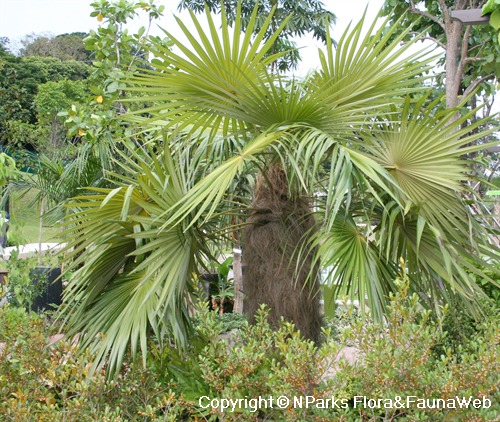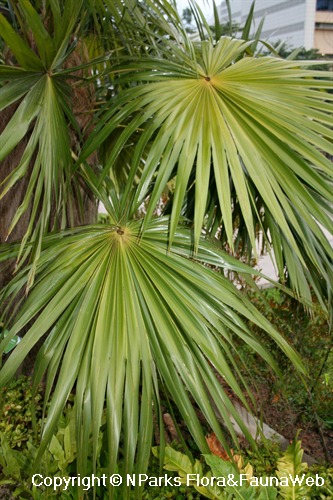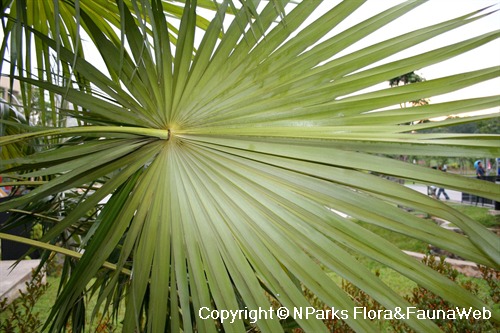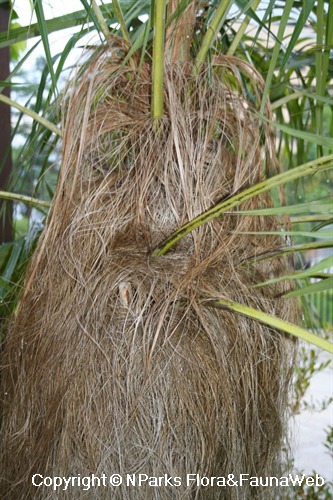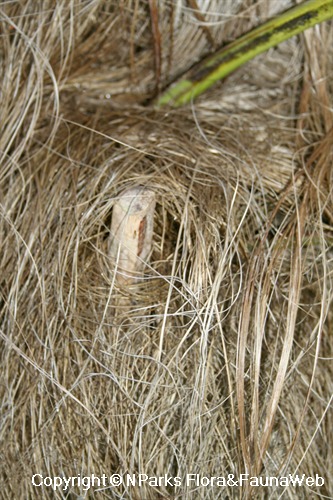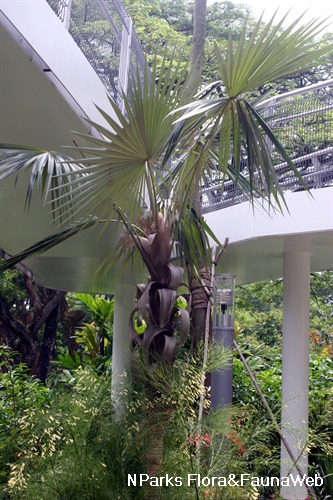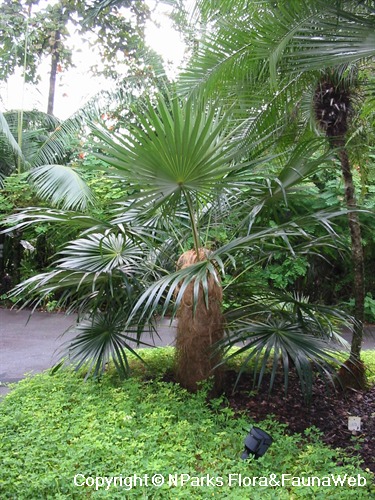
Back
Coccothrinax crinita
| Family Name: | Arecaceae (Palmae) |
| Synonyms: | Thrinax crinita |
| Common Name: | Thatch Palm, Mat Palm, Old Man Palm, Palma Petate, Guano Petate, Guano Barbudo |
Name
Classifications and Characteristics
| Plant Division | Angiosperms (Flowering Seed Plants) (Monocotyledon) |
|---|---|
| Plant Growth Form | Palm (Solitary Habit) |
| Lifespan (in Singapore) | Perennial |
| Mode of Nutrition | Autotrophic |
| Plant Shape | Fountain (Palm-like) |
| Maximum Height | 6 m |
| Maximum Plant Spread / Crown Width | 4.5 m |
| Tree or Palm – Trunk Diameter | 0 |
Biogeography
| Native Distribution | Cuba |
|---|---|
| Native Habitat | Terrestrial (Grassland / Savannah/ Scrubland) |
| Preferred Climate Zone | Tropical |
Description and Ethnobotany
| Growth Form | This slow-growing, medium-sized, solitary palm has a remarkable trunk that is entirely covered with a dense layer fibre, and topped with drooping fronds. |
|---|---|
| Foliage | Fronds are fan-shaped, green above and silvery beneath, deeply segmented unarmed, 1.5 m wide and 0.9 m long. Leaf sheaths disintegrate into masses of white to brown, thick, woolly fibre that envelopes the entire trunk (quite evident even when specimens are only 10 cm tall). |
| Others - Plant Morphology | Flower: Long inflorescences of creamy-white to yellow flowers hang as low as the fronds. Fruit: Fruits are purple to purplish black, globular, about 1 cm to 2.5 cm across. |
| Cultivation | It is sun tolerant, even at an early stage, and it prefers well-drained soils. Propagate by seeds. |
| Etymology | Its genus epithet refers to berry, and 'Thrinax', which means fan (which is also another genus of palm), in reference of its fan-shaped leaves. Species of this genus are often confused with those of Thrinax, but can be easily differentiated by the solid, non-splitting leaf-bases and the fleshy, purplish-black fruit (white in Thrinax), which probably explain the naming of the genus epithet. It species epithet means long-haired, with a mane, referring to the characteristic fibrous trunk. |
| Ethnobotanical Uses | Others: Fronds & fibres from trunk are traditionally used for thatch in native Cuba. |
Landscaping Features
| Desirable Plant Features | Ornamental Stems |
|---|---|
| Landscape Uses | General, Focal Plant |
Plant Care and Propagation
| Light Preference | Full Sun |
|---|---|
| Water Preference | Moderate Water |
| Plant Growth Rate | Slow |
| Rootzone Tolerance | Well-Drained Soils, Disease / Pest Resistant |
| Maintenance Requirements | Moderate |
| Propagation Method | Seed |
| Propagule Establishment Remarks | Seeds take 6 months to germinate. |
Foliar
| Foliage Retention | Evergreen |
|---|---|
| Mature Foliage Colour(s) | Green |
| Mature Foliage Texture(s) | Smooth |
| Foliar Type | Simple / Unifoliate |
| Foliar Shape(s) | Non-Palm Foliage (Palmate), Palm Fronds (Fan / Costapalmate) |
| Foliar Venation | Parallel |
| Typical Foliar Area | Macrophyll ( 182.25cm2 - 1640.25 cm2 ) |
| Leaf Area Index (LAI) for Green Plot Ratio | 2.5 (Palm - Solitary) |
Non - Foliar and Storage
| Trunk Type (Non Palm) | Non Woody |
|---|---|
| Trunk Type (Palm) | Solitary Habit, Aboveground |
| Root Type | Underground (Fibrous Root) |
Floral (Angiosperm)
| Flower & Plant Sexuality | Bisexual Flowers |
| Flower Colour(s) | Yellow / Golden |
|---|
Fruit, Seed and Spore
| Mature Fruit Colour(s) | Purple |
|---|---|
| Fruit Classification | Simple Fruit |
| Fruit Type | Fleshy Fruit , Drupe |
Image Repository
Others
| Master ID | 1321 |
|---|---|
| Species ID | 2614 |
| Flora Disclaimer | The information in this website has been compiled from reliable sources, such as reference works on medicinal plants. It is not a substitute for medical advice or treatment and NParks does not purport to provide any medical advice. Readers should always consult his/her physician before using or consuming a plant for medicinal purposes. |

